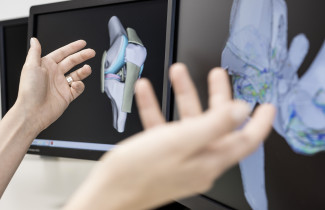When the forces affecting walking are known, the method can be expanded to all research addressing human movement.
- Text Marianne Mustonen
- Photos Raija Törrönen and Teemu Leinonen
Wearable sensors have been used to study human movement for a long time already. However, it is still difficult to obtain detailed information on the internal forces in the body affecting movement.
“For example, it is challenging to measure the forces affecting bones, because bones are inside the body, surrounded by muscles,” says Professor Aki Mikkola of LUT University, Department of Mechanical Engineering.
Accelerometers are typically used for measurement, such as those worn on the wrist of the person being studied. Commercial sports watches unfortunately aren’t good enough for measurement, at least not yet.
“A motion sensor on the wrist doesn’t say much about the loading on the shoulder or the wrist; instead, we need mathematics to calculate it,” says Professor Pasi Karjalainen of the University of Eastern Finland.

“When the simulation model is taught to repeat the same movement, we can eventually get ‘inside’ the skin and assess, for example, pressure distributions in the knee cartilage,” Mikkola says.
Each object, such as a shoulder or a knee, needs to provide its own measurement data.
“We are also looking into how measurements could be performed with as few sensors as possible,” Karjalainen says.
“The trick is to base measurements on computing, and extensive manual processing is no longer needed,” Mikkola says.

Human walking is simulated first
To model movement, a state estimation method where a digital Kalman filter evaluates the state of the system being measured, is used.
“It is impossible to simulate reality in real time. That is why we are performing controlled simulation that is compared to real life,” Mikkola explains.
“We seek to determine the minimum amount of measurement data that is needed to create sufficiently reliable loading estimates,” Postdoctoral Researcher Paavo Vartiainen of the University of Eastern Finland adds.
The first thing to be simulated is human walking. If the method works, it can be expanded and tailored to other forms of movement – to sports or, for example, to the development of ergonomics.

The method will not replace competent physiotherapists.
Researchers
REVIP project
The method will not replace competent physiotherapists but could be used by them as an additional tool in guiding clients either in person or remotely.
One area of interest to the researchers is the ergonomics of care. The project will pilot a method that is based on wearable sensors and a state estimation algorithm, which allows physiotherapists to see if there is any harmful loading during the working day, such as excessive vertebral loading caused by lifting and moving of patients.
“We have previously studied, in a laboratory setting, the impact of a tool that reduces friction on the forces at play when moving patients. Now, one of our objectives is to develop, using wearable motion sensors and pressure sensing insoles, a measurement method and analysis software that is suitable for nurses’ working environment,” Vartiainen says.
The study is based on engineering design research carried out by Mikkola’s research group, which has been applied to cranes used in the forest industry and in excavators, among other things. This existing collaboration between LUT University and the University of Jyväskylä is now supplemented by musculoskeletal biomechanics research carried out in the HUMEA Lab at the Department of Technical Physics of the University of Eastern Finland.
According to Vartiainen, one pilot will be to examine the ergonomics of physicians rehearsing endoscopic surgery.
“During rehearsing in an arthroscopy simulator, we can determine the orientation of the physician’s head and shoulders in real time by using wearable sensors. Based on the pilot cases, it is possible to develop an app that warns the surgeon of a wrong neck position or excessive loading in real time.”
Conducted by the University of Eastern Finland, the University of Jyväskylä and LUT University, the Remote Virtual Physiotherapist, REVIP, is a four-year project which develops real-time computational methods for automated and optimised loading assessment of the musculoskeletal system, to be applied for physiotherapy and rehabilitation.
The method developed in the project uses signals directly from sensors to implement bio-mechanical computer models. Using this method, it is possible to develop applications for measuring and analysing work ergonomics in order to monitor and reduce harmful loading.
The overall funding of the Academy of Finland funded project amounts to 1.4 million euros, and it is led by Professor Aki Mikkola at LUT University, Department of Mechanical Engineering. The HUMEA Lab at the Department of Technical Physics of the University of Eastern Finland contributes to the project expertise in musculoskeletal modelling and sensor technology. The Faculty of Sport and Health Sciences of the University of Jyväskylä focuses on methods for measuring physical activity.
The project partners have extensive international networks, including researchers from Delft University of Technology in the Netherlands, Parker Institute in Denmark, and KU Leuven University in Belgium. The project involves research mobility within the network.
The REVIP project will be completed in summer 2026. The piloting of the method to be developed will mainly take place during the last two years of the project.





